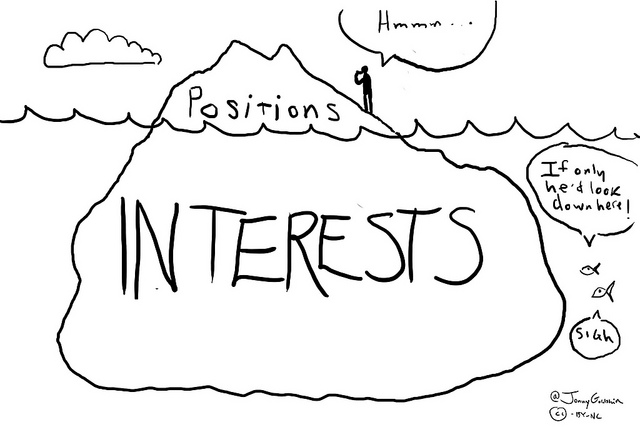Mediating and Reframing
Mediating
The second skill for constructive conversations is mediating. A mediator is an impartial person who can help people with opposing views to find commonality, agreement, and/or understanding. People taking this class, and most people, citizens, are not formal mediators, but all of us at some point find ourselves in a situation where we may be trying to help people find common ground, whether it's two friends at a bar or people at church or the workplace or one's family.
The idea is to use active listening skills to understand two or more people and seek areas of common ground. And again, the key capabilities here are listening, paraphrasing, looking for underlying issues, and where people differ and where they agree. In one of the later activities we'll get into this mediating role.
Reframing
The key goal for a mediator is to help people move from positions to interests, this is called reframing. Look at the cartoon below. First think about what this indicates about the difference between positions and interests. Positions are specific solutions and that is usually what people articulate and what people focus on. But the interests are what's underlying that, so with this iceberg metaphor, it's the interests that are under the water that you can't see. And those are really what you need to try to understand and articulate and unearth.
So again, a position is a specific solution whereas interests are the why, the underlying motivations, hopes, concerns, desires, and worries
Interests motivate people. They are the silent movers behind the hubbub of positions. Your position is something you have decided upon. Your interests are what causes you to so decide. Behind opposed positions lies shared and compatible interests, as well as conflicting ones.
- Fisher and Yuri
For example, a woman who had developed cancer early in her life from exposure to chemicals had a strong position against Marcellus. Her position had everything to do with her interests. She was very concerned about the safety risks because of her personal experience. In this case, her interests would not be apparent unless you take the time to learn about what experiences influenced her position.
Check Your Understanding: Two-Minute Essay
What does this graphic suggest about the difference between positions and interests? Take two minutes and write a response. Set a timer on your computer or a cell phone for two minutes. After your timer chimes, click "Check Answer" to see some of the ideas you should have mentioned.

- We tend to focus on people’s positions because these are easily visible. They are easy to identify; people come right out and say them. For example, “I’m for X” or “I’m against Y.”
- If we want to find out what is motivating someone to take a particular position, we have to find out what their interests are. These are less visible and not something that people readily articulate.
- Underneath every position lies a set of interests that needs to be uncovered.
- Interests are the underlying reasons that a person holds a particular position.
Mediating Role
Mediator
A mediator is an impartial person, who can help people with opposing views to find commonality, agreement, and/or understanding.

Idea
The next time you are with two or more people who are discussing something about which they disagree, take on the role of mediator. Step back from your own viewpoint and seek instead to help the others in your group understand where the other person is coming from. This could be in person or on social media such as Facebook. Use active listening skills (or the equivalent of these skills expressed in writing) to help two or more people find areas of common ground. What did you do? What worked? What didn’t work?
Key skills
Listening, paraphrasing, looking for underlying issues, where they differ, where they agree.